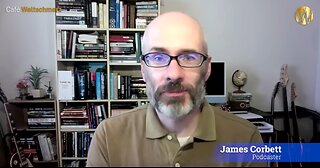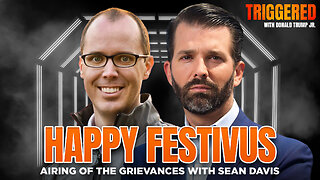Premium Only Content

Propaganda Model of the Media - Noam Chomsky, 1996
Interview between Noam Chomsky and British journalist Andrew Marr
BBC ‘The Big Idea’
One of the most illuminating exchanges during the interview was the following:
Marr: “How can you know I’m self-censoring?”
Chomsky: “I’m not saying you’re self-censoring. I’m sure you believe everything you say. But what I’m saying is if you believed something different you wouldn’t be sitting where you’re sitting.”
Source
https://www.youtube.com/watch?v=GjENnyQupow
_____________________
Propaganda Model of the Media
January 19, 2020 by Matthew Greenwood
https://matthewgreenwood.us/propaganda-model-of-the-media/
In an environment when one is blasted at all sides with distorted, biased, and invented news, it is more important than ever to be an educated consumer of information. In communication theory, there is a powerful model of the media that explains how market forces shape the news we receive. This concept was proposed by Edward Herman and Noam Chomsky in their tome, “Manufacturing Consent: Political Economy and the Mass Media” and termed the “Propaganda Model of the Media.”
First and foremost, the model is not a conspiracy theory. It does not suggest that some shady elites directly control what we see and hear. Instead, it is a model that explains the structural factors that influence the output of the mainstream media. It clarifies what critical thinkers easily observe—that the media works within restricted assumptions, depend heavily and uncritically on elite information sources, and participates in propaganda campaigns helpful to elite interests.
The central insight behind the Propaganda Model is that there are filters through which the “raw material of the news” must pass through before being transmitted to the consumer. The filters decide if an event can be considered news, how it would be covered, the amount of coverage, and how it is placed within the media. The original five filters are ownership of the medium, media’s funding sources, sourcing, flak, and fear ideology.
Filter One: Ownership of the Medium
Filter one is pretty self-explanatory. Running a profitable national media franchise requires enormous capital, and only the immensely wealthy can do it. The mainstream media is composed of a handful of giant conglomerates who are also involved in many other enterprises other than news divisions. It only makes sense that because of conflict of interests, the media will be biased to avoid harming corporate financial interests.
Filter Two: Advertising as Primary Source of Income
Filter Two: Relying on advertisers for revenue makes the media accountable to their advertisers, not the public. Advertisers support programming that caters to the richest because they are the ones with the most to spend. Publications that represent the interests of the working class are at a disadvantage in the advertising competition because their audience has less money to spend.
An example of how market forces silence voices provided by the authors of the Propaganda Model is the case of when the British Socialist-democratic paper, the Daily Herald, went out of business in the 1960s. It actually had twice the readership of the Times, the Financial Times, and The Guardian combined. According to surveys, its readers were more loyal to it than readers of the other papers, but it lacked advertisers. The demise of the Herald has been listed as a factor of the general decline of the Labor Party because they lost a significant voice in the public debate.
Filter Three: Sourcing of Experts
The news business requires a constant flow of information, so they can pass it on. Reporters go where news breaks all the time, like the White House, Pentagon, and Congress. This is news that doesn’t have to be checked since they are deemed reliable due to the source. Government bureaucracies cater to the needs of news organizations, creating a symbiotic relationship by making the work of gathering news easier, less expensive, government-sanctioned, corporate blessed, and sanitized
Experts are usually co-opted by big corporate or government interests, by funding them, sponsoring them, or simply putting them on payrolls. Experts can generally be categorized as government officials, academics coming from think tanks sponsored by corporate interests, corporate consultants, or journalists.
Filter Four: Flak
Flak is the term used to describe punitive action taken towards media statements when particular interests object. Flak comes in many forms from letters, phone calls, lawsuits, speeches, congressional bills, and more. Direct flak would phone calls from the White House to anchormen or producers, demands from the FCC to produce documents, or threat from ad agencies to pull their ads or sue. Indirectly, flak can take several forms that can include when the government or corporations complain about the media to its employees or shareholders or when they fund think tank operations or hire public-relation firms to attack the press or to counter adverse coverage.
Filter Five: Fear Ideology.
When Manufacturing Consent was written, the central noble cause and unquestioned value in American culture was anti-communism. Communism became the malevolent presence by which everything was justified. Communism gave the population an enemy against which to mobilize.
Today we do not have Communism to fear, but since 9/11, a new enemy just as useful arose: terrorism. Today we have an open-ended, vague war that can justify anything. To quote William Greider writing in the Nation: The war on terror “overwhelmed the country, in fact, deranged society’s normal processes and purposes with a brilliantly seductive political message: Terror pre-empts everything else. What this President (George W. Bush) effectively accomplished was to restart the cold war, albeit under a new rubric. The justifying facts are different and smaller, but the ideological dynamics are remarkably similar–a total commitment of the nation’s energies to confront a vast, unseen and malignant adversary. Fanatical Muslims replaced Soviet Communists, and, like the reds, these enemies could be anywhere, including in our midst (they may not even be Muslims, but kindred agents who likewise “hate” us and oppose our values).
Like the Cold War’s logic, this new organizing framework can be compelling to the popular imagination because it runs on fear—the public’s expanding fear of potential dangers. The political commodity of fear has no practical limits. The government can manufacture more. Nor is there any obvious ceiling on what the nation must devote–in JFK’s famous phrase–“to pay any price, bear any burden” in defense of liberty and homeland.”
Filter Six: Miracle of the Market
The principal author of Manufacturing Consent, Edward Herman, suggested in 2000 that an additional filter called “the Miracle of the Market” be included in the Propaganda Model. The new filter recognizes how many Americans hold a near-religious faith in the free market, regardless of evidence. An excellent reference to what Herman was referring to is explained by Eugene McCarraher in his book, The Enchantments of Mammon: How Capitalism Became the Religion of Modernity. McCarraher posits that “Capitalism, is the new religion, a system full of enchanted superstitions and unfounded beliefs and beholden to its own clerisy of economists and managers, its own iconography of advertising and public relations, and its own political theology—a view of history and politics that is premised on the inevitability of the capitalist system spreading across the world.” Such an ideological package makes for an immensely powerful filter that pre-sorts any raw news before being delivered.
Additional Filters
While not in the original work or revised essays Chomsky and Herman discuss other unofficial filters through which news must pass in their other writing.
The Myth of the Liberal Media
There are many well-funded think tanks whose purpose it is to perpetuate the myth that there is a liberal bias in the media… even though the press is demonstrably pro-business, pro-government, and pro-status quo. The accusation of liberal bias ensures that the media steers conservative. The myth of the liberal media also works to discredit any news that is deemed “liberal.”
As long as the media can be called liberal, the conservative establishment sets a limit on what is acceptable discussion. Consumers might say today that they watch FOX News and then CNN news for a balanced outlook (Right and Left). However, by objective standards, FOX news represents far right, and CNN represents center-right, leaving no voice for truly leftist views. The limit has been set and drawn for discussion.
Concision
Concision is the name of the concept academics give of cutting everything to its bare minimum to make it fit with the format of “news.” The news is formatted around commercial breaks every few minutes by sponsors who pay for programming and take about a third of all viewing time. Time limitations prevent news coverage from going into any real depth.
The format of news assures that only conventional ideas pass through the media filter, because ideas everyone knows by heart, require no support. For example, one can say that the USSR invaded Afghanistan, but not that the USA invaded Vietnam—even though they were both invasions in precisely the same way. It is simply not in the American vocabulary that the US has ever been an invading force.
When someone contradicts conventional myths, it requires time to back up their statements. Intellectuals challenging commonly held ideas often come across as long-winded since they take a long time to get to their point as they are contradicting whole narratives that everyone else already “knows.” They must preamble since they may be saying things that are uncomfortable to hear.
Because the structure of mainstream media is designed with short segments around commercial breaks, it is nigh impossible to make a reasoned analysis. The very format of the news ensures only ideas that are simple and already commonly accepted are transmitted.
Patriotism
The news media is constrained in what and how they tell the news to avoid the consequences of appearing too un-patriotic. For example, in the American context, it is terrorism when “they” do it. American foreign policy in general and government agencies specifically are responsible for terrible atrocities and crimes, but when it is covered, it is done within a narrative that protects the pride of patriotic Americans.
Bibliography
Herman, Edward S. The Propaganda Model: A Retrospective, 2003
https://msuweb.montclair.edu/~furrg/hj/hermanretro.pdf
-
Herman, Edward S.; Chomsky, Noam (2010). Manufacturing Consent: The Political Economy of the Mass Media. Random House.
https://archive.org/details/pdfy-NekqfnoWIEuYgdZl
https://files.libcom.org/files/2022-04/manufacturing_consent.pdf
-
 59:54
59:54
InnerLight
1 month agoJames Corbett: New World Order - Influence of Media, Technology and Ideology on our Future! - October 28, 2024
6613 -
 22:45
22:45
Brewzle
18 hours agoI Went Drinking In A Real Bourbon Castle
37.7K3 -
 48:36
48:36
PMG
1 day ago $2.69 earned"Parkland Parent Speaks Out On Kamala Harris Using Victims"
30.1K4 -
 4:06
4:06
The Lou Holtz Show
16 hours agoCoach Lou Holtz’s Heartfelt Christmas Message 🎄 | Family, Faith & Notre Dame Spirit 💚 #christmas
22.3K -
![ROSEANNE BARR - Her Journey, TRUMP, and the MAGA GOLDEN AGE! [INTERVIEW]](https://1a-1791.com/video/s8/1/M/m/B/2/MmB2v.0kob.1-small-ROSEANNE-BARR-Her-Journey-T.jpg) 51:35
51:35
Dr Steve Turley
1 day ago $19.18 earnedROSEANNE BARR - Her Journey, TRUMP, and the MAGA GOLDEN AGE! [INTERVIEW]
57.2K54 -
 57:38
57:38
The Tom Renz Show
14 hours agoMerry Christmas - The Tom Renz Show Christmas
93.4K17 -
 2:59:10
2:59:10
Wendy Bell Radio
1 day agoThe Bridge Too Far
171K301 -
 1:03:45
1:03:45
Donald Trump Jr.
1 day agoHappy Festivus: Airing Our Grievances and Stopping The Swamp w/Sean Davis | TRIGGERED Ep.201
430K549 -
 1:30:30
1:30:30
Game On!
1 day ago $8.09 earnedTop 5 things you need to know for Sports Christmas!
75.8K5 -
 1:58:10
1:58:10
Robert Gouveia
1 day agoMatt Gaetz REJECTS Report, Sues Committee; Luigi Fan Club Arrives; Biden Commutes; Festivus Waste
299K240